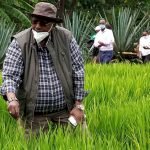After years of research, the Kenya Agricultural and Livestock Research Organisation (KALRO) has launched a seed variety that could expand rice farming beyond traditional rice-growing regions.
Requiring less water, the “komboka” variety suitable for both irrigated and rain fed lowland ecologies, a characteristic that gives it potential for mass market production, thus reducing Kenya’s reliance on imports.
Speaking during the launch in Mwea, Kirinyaga county, KALRO director general Eliud Kireger said demand for rice in Kenya has outstripped local production owing to a rapid expansion of the middle class and urbanisation of people who are increasingly relying on rice for food.
“We have been operating at an average of 200,000 metric tonnes for a long time and farmers however have been pushing the available varieties but have never gone beyond 2.5 to 3 tonnes per hectare,” Dr Kireger said.
The Komboka variety, which has been under development since 2013 in collaborative research between Karlo and International Rice Research Institute (IRRI), can, not only double that in yields but is also cheaper to produce than the mostly preferred Basmati variety.
“The basmati rice is expensive and farmers would rather sell it and buy Pakistani rice which is of poor quality and cheaper. With this one, they will fetch more money and also have enough produce to eat,” he added.
According to Dr Rosemary Murori, a rice breeder working for IRRI, there is inadequate water for irrigated paddy production and therefore the new variety which has higher yields and is drought resistant can be grown even under the rainfed conditions.
“This variety can be grown in western, eastern and even at the coast as it has some relatively high drought tolerance levels and will still do well if there is no water,” she said.

Komboka rice variety by Karlo is high-yielding and requires less water which means it can be rain fed
Dr Murori added that high pre- and post-harvest losses of rice which range from 30 to 40 per cent especially from Quelea birds will be reduced in the komboka because of the structure of the leaf and the way the rice itself is placed
“With good management, a farmer will produce 40 bags of 100kgs per acre compared to Basmati which will yield 20 to 25 bags,” she said.
The researcher, however, added that they are in the process of improving the Basmati 370 variety but said breeding is lengthy and expensive. She said all is in the pipeline and a new improved breed will probably be out in five years.
Dr Kireger invited the private sector to get involved in the commercialisation of the Komboka variety saying it is in line with the National Rice Development Strategy (NRDS 2019/30) overall goal of increasing food security and incomes through sustainable rice production.
“We are partnering with private sector among them the Mwea Rice Cooperative Sacco who are licensed seed producers. As Karlo, we give them the basic seeds which we have bred and they in turn are going to multiply and produce the seeds that will get to the farmers,” he said.
Currently, the demand for rice per individual per year is 20.6 kgs. In 2019, the country produced 195,000 MT, which is projected to increase by 10 per cent to produce 520,000MT by 2030. Despite this, it is expected that rice import dependency ratio will remain high at 88 per cent.
The National Rice Development Strategy (NRDS) of Kenya forecasts that in order for the country to attain self-sufficiency by 2030, the total domestic rice production must increase at a rate of 9.31 per cent annually.
Dr Kireger added that if the country could produce good quantities of the Komboka variety, it could significantly bring down the rice importation bill currently at about Sh23 billion annually.

